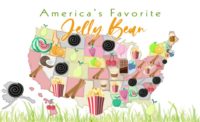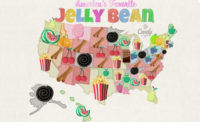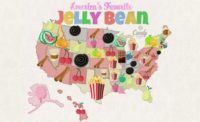It’s said if something isn’t broken, it shouldn’t be fixed — a maxim that has long applied to jelly beans.
Featuring a gel center wrapped in a candy shell, jelly beans have been on the market for at least 150 years. The first mention is attributed to Boston confectioner William Schrafft, who encouraged people to send jelly beans to soldiers during the U.S. Civil War.
While the overall format of jelly beans hasn’t changed much since the 1860s, their simple components make them a perfect vehicle for the flavor innovation that’s needed to break out of seasonal categories.
“Tradition has positioned the jelly bean as an occasional treat, a filler in Easter baskets, or a decorative element for Christmas gingerbread houses,” wrote Marcia Mogelonsky, director of insight, Mintel Food & Drink in 2015 blog post. “Because of its distinctive shape and purpose the candy is rarely eaten out of hand as a major holiday treat – and even more rarely positioned as a ‘sophisticated candy.’”
Karin Vollrath, sales and marketing director for Gimbal’s Fine Candies, would disagree. Gimbal’s, a San Francisco-based maker of gourmet jelly beans, says they’re a feast for the eyes and the mouth.
“There’s no other candy that comes even close to offering the variety that gourmet jelly beans bring to the table,” she said. “For example, Gimbal’s assortment of gourmet jelly beans has something for everyone. So whether you’re craving Sour Cherry, Strawberry Cheesecake or even Buttered Popcorn, you’ll be sure to find something you love. The colors in our assortment just add to the fun.”
In addition to offering 41 flavors in its traditional assortment, Gimbal’s has introduced a sour assortment and mixes of heart-shaped pieces that cater to lovers of specific flavors — Cherry and Cinnamon. Vollrath said Gimbal’s will launch a single-flavor option and another assortment next year.
“We find that inherent in the nature of gourmet jelly beans consumers get big flavor in a little package — so basically a little bit goes a long way,” Vollrath said.
Jelly Belly Candy Co. has never been afraid to play with flavor, notes Robert Swaigen, Jelly Belly’s v.p. of global marketing.
“Jelly Belly offers true-to-life flavors that create an experience similar to eating the real thing,” Swaigen said. “The breadth and depth of our bold flavors take consumers on a unique flavor adventure with every Jelly Belly bean they enjoy. We have more than 100 flavors and a wide range from Buttered Popcorn to Toasted Marshmallow.”
Some of Jelly Belly’s flavors don’t even taste good, but that’s just how the Fairfield, Calif.-based company likes it. BeanBoozled, a roulette-style game featuring tasty and terrible jelly bean flavors, has riveted and revolted fans online and off for 10 years.
Jelly Belly recently released the fifth edition of BeanBoozled featuring Stink Bug, which has similar coloring to Toasted Marshmallow, and Dirty Dishwater, which looks like the Birthday Cake beans.
“Consumers expect new and unique products,” Swaigen said. “With the fifth edition, we have introduced two new weird and wild flavors to keep BeanBoozled fans on their toes.”
The expertise in less-than-delicious flavors also helps when it comes to developing varieties for Jelly Belly’s “Harry Potter” license Bertie Bott’s Every Flavour Beans. Jelly Belly recently expanded and redesigned its “Harry Potter” line featuring three new Bertie Bott’s items, including a 4.25-oz. gift box with only unusual flavors.
“Licensed products help us reach new consumers and keep our products relevant,” Swaigen said. “Working with brands like Disney, Star Wars and Harry Potter helps ensure that we deliver new and exciting products to consumers around the world.”
And much like other confectionery categories, jelly beans are not immune to the movement to clean up ingredient decks. Jelly Belly’s line of organic jelly beans are made with non-GMO ingredients and are certified OU Kosher and vegetarian. They’re also free of gelatin, gluten, peanuts, fat and dairy.
Over the last year, Ferrara Candy Co. also tested organic jelly beans under its Black Forest brand. Along with being USDA-certified organic, the beans were made with colors and flavors from natural sources.
“As with broader confections, we are seeing opportunities for an all-natural or organic jelly beans, though at this point, the opportunities are more limited to select accounts or the channels that cater to the broader natural grocery trend in general,” said Peter Goldman, senior director, Brach’s & Seasonal Confections. “We … are evaluating how to grow the brand and form in the future.”
Ferrara has also parlayed the increasing strength of its Trolli brand into the jelly bean category. According to IRI, a Chicago-based research firm, Trolli’s Sour Brite Crawlers pulled in just over $130 million in the year ending Sept. 9, up 10 percent from the year before.
“This past Easter we introduced Trolli Sour Brite Jelly Beans to strengthen our position in sour while also leveraging the growth and equity of the Trolli brand at Easter,” Goldman said.
Nonetheless, Brach’s traditional jelly beans perform well, Goldman said.
“Our most popular flavor is actually a mix of classic fruit flavors, which is consistent with the best sellers in the broader category,” he said. “Our Black Jelly Bird eggs which are licorice flavored and only available during the Easter season do well also.”
Whether they’re in candy dishes or Easter baskets — or their flavors are classic or creative — beans are here to stay.






